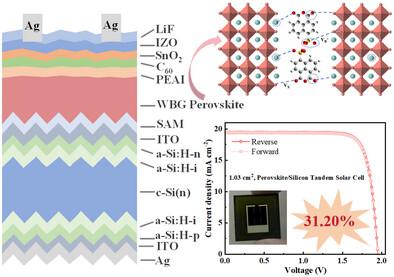双锚定抑制31.20%钙钛矿/硅串联太阳能电池卤化物偏析
IF 26
1区 材料科学
Q1 CHEMISTRY, PHYSICAL
引用次数: 0
摘要
宽禁带钙钛矿太阳能电池(PSCs)的效率和稳定性受到光致卤化物偏析和严重的非辐射复合的限制,这严重阻碍了高效稳定的钙钛矿/硅串联太阳能电池(PSTSCs)的发展。在这项工作中,将具有双锚定位点的4-磺酸-1,8-萘酸酐钾盐(4S-NAPS)掺入钙钛矿前驱体中。硫基(SO3−)和羰基(C = O)在钙钛矿表面与不配位的Pb2+离子相互作用。此外,K +离子占据了晶格内的间隙位,从而有效增强了离子迁移屏障,抑制了卤化物相分离。由于4S-NAPS的双锚定效应,单结WBG PSC (1.68 eV)的功率转换效率(PCE)为22.95%,开路电压(VOC)为1.26 V,是目前WBG PSC中效率最高的器件之一。此外,未封装的改性装置在氮气气氛中放置3000 h后仍保持90%的初始效率,表现出显著的操作稳定性。值得注意的是,制作的单片PSTSC的PCE为31.20%,VOC为1.950 V,并且具有可忽略不计的滞后。这种双锚定策略为制造高效稳定的WBG pssc提供了一条有前途的途径,并为实现pssc的卓越性能提供了新的见解。本文章由计算机程序翻译,如有差异,请以英文原文为准。

Suppressing Halide Segregation Via Dual-Anchoring Strategy for 31.20% Perovskite/Silicon Tandem Solar Cells
The efficiency and stability of wide bandgap (WBG) perovskite solar cells (PSCs) are constrained by photo-induced halide segregation and severe non-radiative recombination, which significantly impedes the advancement of high-efficiency and stable perovskite/silicon tandem solar cells (PSTSCs). In this work, a potassium 4-sulfonic-1,8-naphthalic anhydride salt (4S-NAPS), featuring dual-anchoring sites, is incorporated into the perovskite precursor. The sulfonic group (─SO3−) and carbonyl group (C═O) interact with uncoordinated Pb2+ ions on the perovskite surface. In addition, K⁺ ions occupy interstitial sites within the crystal lattice, thereby effectively enhancing the ion migration barrier and suppressing halide phase separation. Owing to the dual-anchoring effect of 4S-NAPS, a single-junction WBG PSC (1.68 eV) delivers a power conversion efficiency (PCE) of 22.95% and an open-circuit voltage (VOC) of 1.26 V, representing one of the highest efficiencies reported for WBG PSCs. Moreover, the unencapsulated modified devices retain 90% of initial efficiency after 3000 h in a nitrogen atmosphere, demonstrating remarkable operational stability. Notably, the fabricated monolithic PSTSC achieves a PCE of 31.20%, a VOC of 1.950 V, and exhibits negligible hysteresis. This dual-anchoring strategy provides a promising avenue for fabricating highly efficient and stable WBG PSCs and offers new insights into achieving superior performance in PSTSCs.
求助全文
通过发布文献求助,成功后即可免费获取论文全文。
去求助
来源期刊

Advanced Energy Materials
CHEMISTRY, PHYSICAL-ENERGY & FUELS
CiteScore
41.90
自引率
4.00%
发文量
889
审稿时长
1.4 months
期刊介绍:
Established in 2011, Advanced Energy Materials is an international, interdisciplinary, English-language journal that focuses on materials used in energy harvesting, conversion, and storage. It is regarded as a top-quality journal alongside Advanced Materials, Advanced Functional Materials, and Small.
With a 2022 Impact Factor of 27.8, Advanced Energy Materials is considered a prime source for the best energy-related research. The journal covers a wide range of topics in energy-related research, including organic and inorganic photovoltaics, batteries and supercapacitors, fuel cells, hydrogen generation and storage, thermoelectrics, water splitting and photocatalysis, solar fuels and thermosolar power, magnetocalorics, and piezoelectronics.
The readership of Advanced Energy Materials includes materials scientists, chemists, physicists, and engineers in both academia and industry. The journal is indexed in various databases and collections, such as Advanced Technologies & Aerospace Database, FIZ Karlsruhe, INSPEC (IET), Science Citation Index Expanded, Technology Collection, and Web of Science, among others.
 求助内容:
求助内容: 应助结果提醒方式:
应助结果提醒方式:


